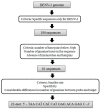A Sensitive and Selective Label-Free Electrochemical DNA Biosensor for the Detection of Specific Dengue Virus Serotype 3 Sequences
- PMID: 26140346
- PMCID: PMC4541844
- DOI: 10.3390/s150715562
A Sensitive and Selective Label-Free Electrochemical DNA Biosensor for the Detection of Specific Dengue Virus Serotype 3 Sequences
Abstract
Dengue fever is the most prevalent vector-borne disease in the world, with nearly 100 million people infected every year. Early diagnosis and identification of the pathogen are crucial steps for the treatment and for prevention of the disease, mainly in areas where the co-circulation of different serotypes is common, increasing the outcome of dengue hemorrhagic fever (DHF) and dengue shock syndrome (DSS). Due to the lack of fast and inexpensive methods available for the identification of dengue serotypes, herein we report the development of an electrochemical DNA biosensor for the detection of sequences of dengue virus serotype 3 (DENV-3). DENV-3 probe was designed using bioinformatics software and differential pulse voltammetry (DPV) was used for electrochemical analysis. The results showed that a 22-m sequence was the best DNA probe for the identification of DENV-3. The optimum concentration of the DNA probe immobilized onto the electrode surface is 500 nM and a low detection limit of the system (3.09 nM). Moreover, this system allows selective detection of DENV-3 sequences in buffer and human serum solutions. Therefore, the application of DNA biosensors for diagnostics at the molecular level may contribute to future advances in the implementation of specific, effective and rapid detection methods for the diagnosis dengue viruses.
Keywords: DNA biosensors; dengue fever; differential pulse voltammetry; electrochemical detection; guanine oxidation.
Figures






Similar articles
-
A genosensor for detection of consensus DNA sequence of Dengue virus using ZnO/Pt-Pd nanocomposites.Biosens Bioelectron. 2017 Nov 15;97:75-82. doi: 10.1016/j.bios.2017.05.047. Epub 2017 May 27. Biosens Bioelectron. 2017. PMID: 28577500
-
Label-free electrochemical detection of the specific oligonucleotide sequence of dengue virus type 1 on pencil graphite electrodes.Sensors (Basel). 2011;11(6):5616-29. doi: 10.3390/s110605616. Epub 2011 May 26. Sensors (Basel). 2011. PMID: 22163916 Free PMC article.
-
Biosensor for dengue virus detection: sensitive, rapid, and serotype specific.Anal Chem. 2002 Mar 15;74(6):1442-8. doi: 10.1021/ac015675e. Anal Chem. 2002. PMID: 11922316
-
Innovations in dengue virus detection: An overview of conventional and electrochemical biosensor approaches.Biotechnol Appl Biochem. 2024 Jun;71(3):481-500. doi: 10.1002/bab.2553. Epub 2024 Jan 15. Biotechnol Appl Biochem. 2024. PMID: 38225854 Review.
-
Electrochemical biosensing of mosquito-borne viral disease, dengue: A review.Biosens Bioelectron. 2019 Oct 1;142:111511. doi: 10.1016/j.bios.2019.111511. Epub 2019 Jul 13. Biosens Bioelectron. 2019. PMID: 31319325 Review.
Cited by
-
Ultrasensitive detection of pathogenic viruses with electrochemical biosensor: State of the art.Biosens Bioelectron. 2020 Oct 15;166:112431. doi: 10.1016/j.bios.2020.112431. Epub 2020 Jul 16. Biosens Bioelectron. 2020. PMID: 32862842 Free PMC article. Review.
-
Recent Advances in DNA Nanotechnology-Enabled Biosensors for Virus Detection.Biosensors (Basel). 2023 Aug 15;13(8):822. doi: 10.3390/bios13080822. Biosensors (Basel). 2023. PMID: 37622908 Free PMC article. Review.
-
Toward Development of a Label-Free Detection Technique for Microfluidic Fluorometric Peptide-Based Biosensor Systems.Micromachines (Basel). 2021 Jun 13;12(6):691. doi: 10.3390/mi12060691. Micromachines (Basel). 2021. PMID: 34199321 Free PMC article.
-
Biosensors for the detection of flaviviruses: A review.Synth Syst Biotechnol. 2024 Oct 26;10(1):194-206. doi: 10.1016/j.synbio.2024.10.005. eCollection 2025. Synth Syst Biotechnol. 2024. PMID: 39552759 Free PMC article. Review.
-
Portable Sensing Devices for Detection of COVID-19: A Review.IEEE Sens J. 2021 Feb 16;21(9):10219-10230. doi: 10.1109/JSEN.2021.3059970. eCollection 2021 May 1. IEEE Sens J. 2021. PMID: 36790948 Free PMC article.
References
-
- WHO . Dengue—Guidelines for Diagnosis, Treatment, Prevention and Control. WHO Press; Geneva, Switzerland: 2009. p. 147. - PubMed
Publication types
MeSH terms
Substances
LinkOut - more resources
Full Text Sources
Other Literature Sources

